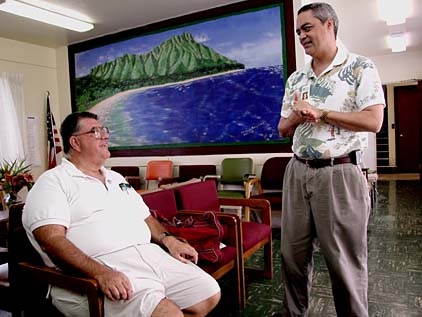
CRAIG T. KOJIMA / CKOJIMA@STARBULLETIN.COM
Dennis Carreira, left, lost his job and has no health insurance. He is not alone. Dr. Elliot Kalauawa, right, of the Waikiki Health Center, says 40 percent of his patients are uninsured.
Health often suffers
with lost insuranceMore isle residents are
relying on community centers
that cannot treat all ailments
A 52-year-old Aiea man who lost his job nine months ago says he feels he is on a merry-go-round, going in circles trying to find work and take care of his medical problems.
Dennis Carreira is one of more than 27,300 uninsured residents depending on the state's 10 community health centers to meet their health needs.
Uninsured patients have increased 67 percent since 1997, said Beth Giesting, executive director, Hawaii State Primary Care Association.
The Kokua Kalihi Valley center has had the largest percentage increase, but the Kauai center, which just opened, has the greatest percentage of uninsured patients, she said. Centers offering dental services have extensive waiting lists, she said.
Carreira goes to the Waikiki Health Center for treatment of myriad health problems, including high blood pressure, asthma, Type II diabetes, bronchitis and psoriasis.
He lost his medical insurance when he lost his job at a parking garage, he said. His wife works at a hospital but missed a deadline to get him on her plan, and he did not qualify for the state's QUEST program because his wife earns $20 more than the eligibility limit, he said.
"Stress is the major thing," he said, "because psoriasis, when I first got laid off, was just a small patch on my leg. Now it's spreading over my legs and sides."
The health center gives him some medicine but cannot supply him with diabetes test strips or psoriasis pills, which cost $456 for 30, he said.
"I've been to over 100 places already (job-hunting), and nothing," he said. "Agencies don't want to bother to help you if you're not disabled or not on welfare." He said he has a license to teach organ and keyboard but cannot recruit students.
Dr. Elliot Kalauawa at the Waikiki Health Center said about 40 percent of patients are uninsured, including self-employed people with small businesses who cannot afford premiums.
The center has a sliding fee scale. No one is turned away who cannot pay anything, but problems arise if they need drugs or tests they cannot afford, he said.
"Sometimes I feel like I'm practicing in a Third World country, because patients can't get the tests they need," said Kalauawa, who left a private practice in Kaneohe 17 years ago to join the center.
"I sort of end up practicing medicine like medicine used to be practiced before, with less reliance on tests and more on physical diagnosis, clinical skills and history-taking."
He said patients are showing up much sicker than in the past because many have to choose between medicine and food and wait until the last minute to see a doctor.
"Unfortunately, many of these people who are uninsured are people who don't necessarily vote, so they don't have good representation," said Chuck Braden, Waimanalo Health Center executive director.
"These aren't like constituents putting pressure on anybody. The pressure is on the health centers."
The Waimanalo center has about 225 to 250 uninsured visits monthly out of an average 1,000, said Greig Gaspar, marketing specialist.
"What's kind of interesting is because they've become uninsured, their regular physicians won't see them," he said. "They send them to the health center and say, 'Come back when you get reinsured.'"
Joan White, executive director of the Hawaii Uninsured Project, established to address problems of the uninsured, said one of the work groups is focusing on the prepaid health care act because nearly 60 percent of the uninsured are working people.
"That's almost 70,000 people who are gainfully employed but do not have health insurance."
She said the groups are gathering data, working with researchers and focus groups, and hope to have most of the work done for a conference the end of October.
Funding is a nagging worry for the community centers, which have $2.1 million in state funding for the uninsured this fiscal year, Giesting said. An additional $1.45 million from the Legislature has not been released, she said, noting the governor can restrict the amount of contracts issued by the state Health Department.
Earlier this year, the administration cut $1.6 million from supplemental funds for the centers but later restored it.
Jane Kadohiro, state health deputy director, said the department is putting everything on hold until next month's report from the Council on Revenues, which makes revenue projections for the state. "We want to make sure we've got real good data on which to make financial decisions," she said.
Gov. Linda Lingle and other dignitaries visited some community centers during open houses last week to recognize National Community Health Week. Lingle was pronounced in top shape after diabetes, blood pressure and cholesterol tests at the Waimanalo clinic.
Giesting said the Primary Health Care Association is looking into ways to tell the community "about the excellent care the centers provide and how critical they are to the whole health care system working. ... We need to find better ways to make sure the health centers are not endangered when other funds disappear."
